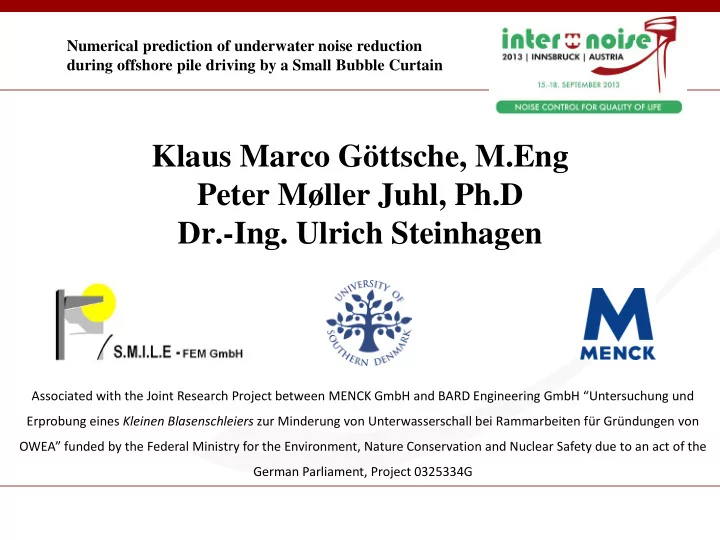

Numerical prediction of underwater noise reduction during offshore pile driving by a Small Bubble Curtain Klaus Marco Göttsche, M.Eng Peter Møller Juhl, Ph.D Dr.-Ing. Ulrich Steinhagen Associated with the Joint Research Project between MENCK GmbH and BARD Engineering GmbH “Untersuchung und Erprobung eines Kleinen Blasenschleiers zur Minderung von Unterwasserschall bei Rammarbeiten für Gründungen von OWEA” funded by the Federal Ministry for the Environment, Nature Conservation and Nuclear Safety due to an act of the German Parliament, Project 0325334G
Numerical prediction of underwater noise reduction during offshore pile driving by a Small Bubble Curtain • Motivation • Concept of the Small Bubble Curtain • Simulation of the unprotected case • Attenuation due to Bubble Curtain • Comparison to measurements • Conclusion 15. – 18. September 2013 Contents
Numerical prediction of underwater noise reduction during offshore pile driving by a Small Bubble Curtain • Driven steel piles are the most common method for funding offshore wind turbines and platforms. • Piles are driven by hydraulic hammers up to 40 m deep. • This leads to high noise emission under water. • To protect the maritime fauna, the noise level has to be reduces (e.g. in Germany: 160 dB SEL in 750 m). • Small Bubble Curtains (SBC) are an effective method to reduce the noise. • The goal is to develop a numerical method to predict the noise level due to pile driving and to determine the attenuation due to a SBC. 15. – 18. September 2013 Motivation
Numerical prediction of underwater noise reduction during offshore pile driving by a Small Bubble Curtain • The pile is enclosed by a system of hoses or pipes. • Air is injected through holes. • Air bubbles surround the entire pile. • Noise reduction by: • Air bubbles reduce impedance of the water • Reduced radiation due to pile vibration • Reflection, Absorption and Scattering of pressure wave Prototype of SBC by MENCK 15. – 18. September 2013 Concept of the Small Bubble Curtain
Numerical prediction of underwater noise reduction during offshore pile driving by a Small Bubble Curtain • The noise radiation in the near field is solved by FEM. • An axial symmetric model containing solid and acoustic fluid elements is used. • The transient pressure is exported for a vertical array of points. • The pressure spectrum is determined for each point by FFT. Near field by FEM 15. – 18. September 2013 Simulation of the unprotected case
Numerical prediction of underwater noise reduction during offshore pile driving by a Small Bubble Curtain • Transmission Loss is determined for each source to a common receiver • TL is applied to the spectrum from the FEM • Receiving spectrum is determined • SEL is determined by integration of the spectrum Near field by FEM TL by e.g. Parabolic equation / Wavenumber integration 15. – 18. September 2013 Simulation of the unprotected case
Numerical prediction of underwater noise reduction during offshore pile driving by a Small Bubble Curtain • The bubble distribution is determined by CFD-Simulation using Euler particle model. • The volume fraction is exported in a 2D grid. • The depth division is the same like the sources from the FEM. • Within each cell, the Volume Fraction is assumed to be constant. 15. – 18. September 2013 Attenuation due to bubble curtain
Numerical prediction of underwater noise reduction during offshore pile driving by a Small Bubble Curtain • A uniform or Gaussian bubble distribution is assumed for each cell. • The transmission coefficient for each cell is determined by Effective Medium Approach (EMA) as a function of frequency, range and depth. • EMA considers bubble cloud as an oscillating continuum. 15. – 18. September 2013 Attenuation due to bubble curtain
Numerical prediction of underwater noise reduction during offshore pile driving by a Small Bubble Curtain Attenuation due to EMA • For each depth a total transmission coefficient is determined. • The transmission coefficient is considered as reduction of the source strength. Near field by FEM TL by e.g. Parabolic equation / Wavenumber integration 15. – 18. September 2013 Attenuation due to bubble curtain
Numerical prediction of underwater noise reduction during offshore pile driving by a Small Bubble Curtain 750 m Distance from the pile, 30 m below water level SEL without SBC SEL with SBC Attenuation Measurement 173.6 dB 159.8 dB 13.8 dB Simulation 177.6 dB 159.3 dB 18.3 dB 15. – 18. September 2013 Comparison to measurements
Numerical prediction of underwater noise reduction during offshore pile driving by a Small Bubble Curtain Thank you for your attention ! 15. – 18. September 2013
Recommend
More recommend